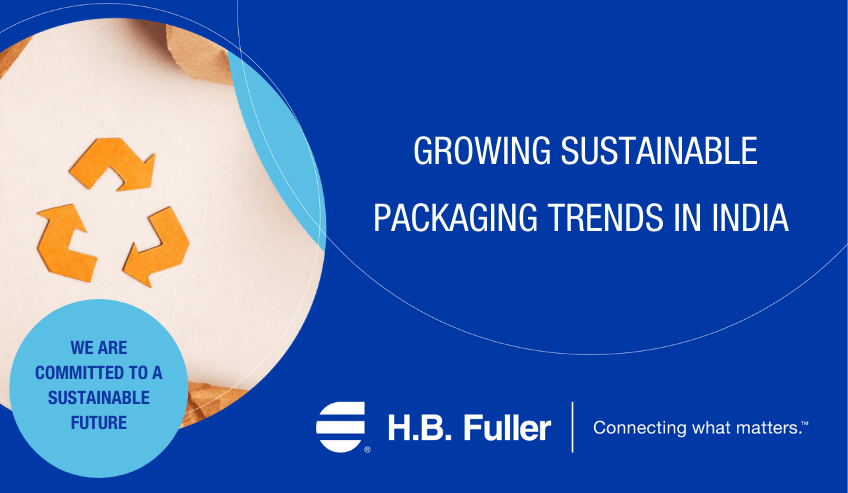
胶水话题博客

对更高效和环保的包装需求正在增加。一些发展最快的品牌已经走在了前面。许多企业正在消除废弃产品,如包装单和第三方营销材料。可持续发展在企业中迅速获得关注,消费者越来越多地要求环保产品。在印度和中国等发展中国家,特别是日益壮大的中产阶级越来越意识到某些包装带来的健康和环境风险,从而推动了这一趋势。良好的环境表现和商业价值可以共存,因此,慎重对待可持续发展需求的制造商可以获得竞争优势。
根据Smithers最近的报告,The Future of Packaging: Long-Term Strategic Forecast to 2028,“全球包装市场预计在2018年至2028年间每年增长约3%,达到超过1.2万亿美元。”消费者越来越关注能够展示对环境承诺的包装材料和设计。
市场概述
在2021年至2026年期间,印度的包装行业预计将以近27%的速度增长。为了防止COVID-19疫情的蔓延,大多数发达国家要么焚烧废纸,要么将其用作填埋(参考:Mordor Intelligence的行业报告)。瓦楞纸箱制造商正在努力将包装运输给基本商品的制造商,包括食品和其他消费品、医疗和制药产品、纸巾和卫生产品,但对于许多印度造纸厂来说,获取原材料变得越来越困难。
- 由于人口增加、收入水平提高、生活方式变化、通过互联网和电视等媒体的渗透增加以及经济增长,包装需求正在增长。根据印度领先的信用评级机构Care Ratings,印度生产的纸张中有超过49%用于包装用途。
- 制药和食品饮料行业的大量投资正在推动包装市场的快速扩展。
- 印度中产阶级的崛起、有组织零售的迅速扩展、出口的增加以及印度电子商务部门的兴起都在助力增长。根据印度包装研究所(IIP)的数据,印度的包装消费在过去十年中激增了200%,从每人每年4.3公斤增长到8.6公斤。
变化的感觉
品牌所有者继续在包装选择中优先考虑可持续性。
完全由回收材料制成的包装的转变正由PET饮料瓶引领:
- 根据Smithers的《2020年包装行业状况》,百加得承诺从2023年开始使用8000万个完全由可生物降解的PHA生物聚合物制成的塑料瓶。
- 许多大型快速消费品公司表示,他们将在2025年前使所有包装都可回收。
随着越来越多的商品直接分发给客户,电子商务包装的可回收性和再利用变得更加重要。例如,RePack的回收塑料邮袋可以承受20次在线客户交付,并适用于退货运输。每年全球发送的五十亿件亚马逊商品需要大量的包装材料。因此,亚马逊开发了“无挫折包装”计划,以减少其对环境的影响,同时满足客户对减少过度包装的需求。
增长加速器
消费者意识
全球范围内,海洋和海洋塑料废物影响的情感视觉引发了消费者情绪,推动了制造过程的变化。印度包装行业在过去十年中迅速增长,这得益于基材选择的变化和替代解决方案的扩散。为了满足客户对可持续材料的需求,甘蔗渣、玉米淀粉和PLA作为塑料替代品的使用有所增加。
政府法规
全球各国政府都对包装废物,特别是一次性包装废物的公众关注做出了回应,制定了减少环境废物的标准,同时改善废物管理系统。目前,印度推迟了全面禁止一次性塑料的计划,转而进行更多的塑料废物意识宣传活动和更多的收集站,以改善废物收集和减少废物。
可持续的未来
根据最近的一份Capgemini报告《可持续性和消费者行为变化》,79%的消费者由于社会责任、包容性或环境影响而改变了他们的购买偏好。一次性塑料占浪费和处理的包装废物的70%以上,这些废物要么堆积在海洋底部,要么堆积在垃圾山上,要么导致碳排放。包装制造商及其供应商,如H.B. Fuller,正在合作开发更环保的包装产品。
随着新技术的出现和更大的跨国消费品公司对其可持续发展活动变得更加透明,找到最佳服务客户的方法可能会令人不知所措。H.B. Fuller的Connecting what matters不仅仅是粘合剂,还包括为您的可持续包装需求匹配合适的主题专家。我们以粘合剂、密封剂和功能性涂料技术和解决方案为主导,帮助解决当前和未来的全球环境和社会问题。点击这里了解更多。

Blog Categories
Blog Categories
Archive
- 2025
- 2024
- 2023
- 2022
- 2021
